Project Log: Tuesday, February 18, 2014
After water-washing, I lightly sanded the new fiberglass
on the battery boxes to remove any sharp spots and
prepare for the next steps. Then, I prepared two
mahogany cleats for the port box, to raise the box high
enough to avoid contact with the hull at the after
corner. This simple project ended up requiring a
number of trips up and down to the engine room, checking
the fit, before I found the right combination of height
and length. My first attempt didn't raise the box
enough; then, a new, higher set of cleats was too long,
so the cleat itself hit the hull at the after location.
Finally, after shortening the after cleat, I got the
right combination.
To permanently attach the cleats, I set them in
thickened epoxy adhesive, and secured with screws from
beneath.
|
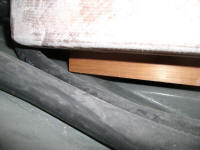
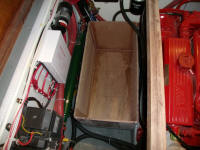
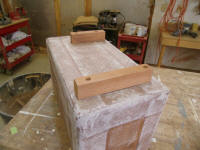
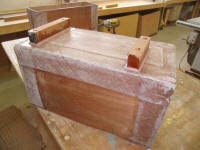 |
Next, I epoxy-coated the cleats, then turned the boxes
over and coated the inside surfaces, as well as another
coat on the exterior. |
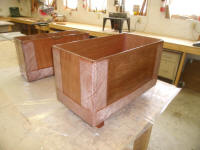
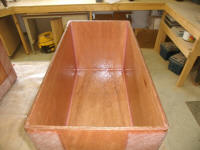
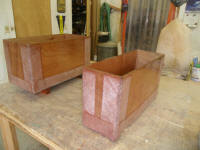
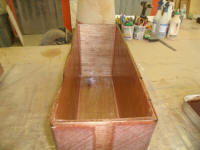
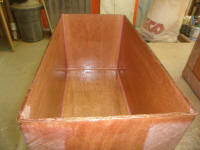 |
I'd hoped to be done (such as exterior varnish work is
ever truly "done") with the running boards, but upon
inspection I found one holiday I couldn't live with, so
I sanded again and applied another coat. |
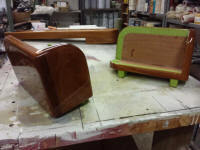 |
I masked off around the bulwark planks and rubrails--the
spaces between the bulwarks were too narrow for any tape
I had, so I left those areas untaped--and cleaned up the
surfaces to prepare for their varnish buildup.
Then, in a long varnishing session, I revarnished the
caprails, and applied a coat to the bulwarks and
rubrails on both sides. No direct pictures of the
caprails this time since I'd removed the ladder for
access to the bulwarks, and didn't want to move it
around again and risk shaking up dust afterwards.
I used different concentrations of varnish for the two
jobs, since the caprails were well advanced in their
buildup (and I was using barely-thinned varnish there),
and the bulwarks were at an earlier stage and required
thinner varnish still. |
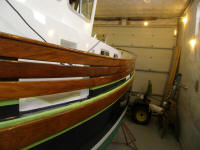
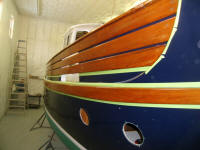
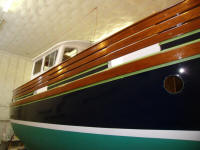
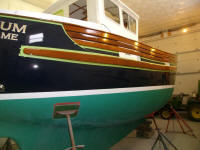
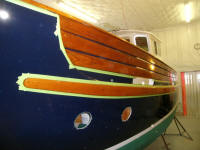
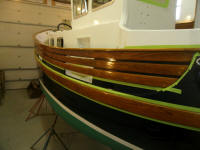
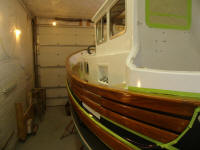
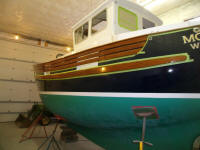
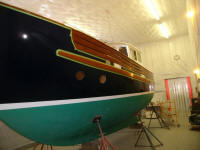 |
With an hour left in the day, I turned to the handrails.
On this boat, the handrails were simple planks, about
1-1/2" wide, that attached over raised, molded risers in
the coachroof and pilothouse, and I'd removed them very
early in the project, sticking them deep into storage
somewhere. I'd anticipated building new ones, but
when I pulled out the originals I was surprised to find
that, old finish notwithstanding, they looked pretty
decent, so I decided to reuse them. All the old
teak on this boat had plenty of character, to say the
least, and while none was perfect, it was all perfectly
fine.
In the event, I quickly stripped the remaining finish (Cetol,
yuck) and the worst of the gray weathering with coarse
paper on a more aggressive sander, then finish-sanded
the four pieces with a vibrating sander, working through
the grits to remove old finish, weathering, and clean up
and smooth the surfaces. |
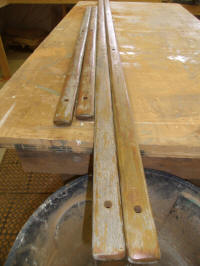
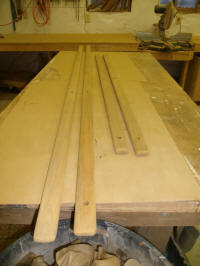 |
| |
Total Time Today: 5 hours
|
<
Previous | Next > |
|
|






















